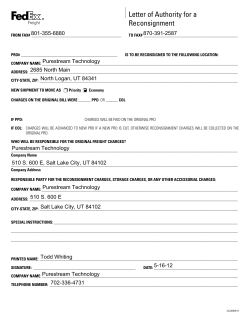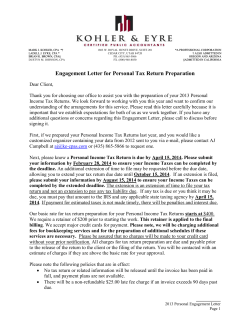
Chemistry for the gifted and talented 49 Formal charge
Chemistry for the gifted and talented Formal charge Student worksheet: CDROM index 25SW Discussion of answers: CDROM index 25DA Topics Transition state, resonance structures, reactive intermediates, carbocations and electronegativity. Level Very able post–16 students. Prior knowledge Dot and cross diagrams, dative bonds, oxidation numbers and curly arrows in organic mechanisms. Rationale This activity introduces formal charge – a useful tool which otherwise might not be taught. The formal charge model treats bonds as pure covalent, in contrast to the oxidation state model which treats bonds as ionic. These two models should be seen as opposite ends of a continuum with the real charge on atoms being somewhere in between the two. This activity explores the usefulness of the formal charge model and gives the students the experience of refining a model when it starts to fail and realising situations when it should be abandoned in favour of other models. It encourages the students to think of quantities like formal charge and oxidation number as useful models with artificial rules that do not represent accurately the real electron density distribution in molecules. The students are asked to suggest rules to help cope with transition metals – this should help them appreciate the design of the rules they use for assigning oxidation numbers. It gives a good rationale for the charges in organic mechanisms. The students should 49 50 Chemistry for the gifted and talented uncover the link between formal charge and dative bonds. Use It can be used as a differentiated activity for the most able in a mixed ability group or for a whole class with teacher support. If used with a whole class, rather than getting them to wade through the lengthy instructions, it would be good to go through a few examples together so that they quickly get a feel for how it works. Less able students found the instructions a lot to read and digest without support. It could be done in two parts, part 1 being the introduction and questions 1–5 with part 2 being the remainder. This symbol means those questions are best tackled as a discussion if a group of students is doing this activity. It is intended that written answers are not required for these questions. Question 9 is included mainly for those who want some more background. Student worksheet Chemistry for the gifted and talented Formal charge Working through this activity should enable you to explain why the charges appear and disappear in organic mechanisms such as and predict the most likely structure from a list of alternatives like these proposed structures for the sulfate ion. A formal charge can be allocated to each atom by assigning ownership of the electrons to particular atoms (this is not the same as ‘remembering’ which atoms the electrons came from that are used in bonding). We assume that: • each atom has an equal share of a bonding electron pair (one each), even if the bond is a dative one; and • an atom owns its lone pairs completely. If this assignment results in the atom having more electrons than in the isolated atom, the formal charge of the atom is negative (–1 for one extra electron, –2 for two extra electrons etc). If this assignment results in the atom having less electrons than in the isolated atom, the formal charge of the atom is positive (+1 for one less electron, and so on). For example, the carbonate ion. continued on page 2 Student worksheet 25SW Formal charge Page 1 of 7 Chemistry for the gifted and talented The carbon, in the carbonate ion, has 4 x 1 = 4 electrons assigned to it (one from each of its four bonds), therefore it has a formal charge of zero (neutral). The top oxygen has two lone pairs and two bonding pairs giving a total of 4 + 2 = 6 electrons. Thus the formal charge on this oxygen is also zero. The bottom two oxygen atoms each have three lone pairs and one bonding pair, giving 6 + 1 = 7 electrons, and therefore a formal charge of –1. Notice that the sum of the formal charges on all the atoms equals the total charge on the whole ion. A more mathematical way of defining the formal charge on a particular atom is given by the expression Where: F is the formal charge V is the number of valence electrons in the isolated atom (eg for carbon V = 4) L is the number of lone pair electrons B is the number of bonding electrons on that particular atom If the formal charges on the individual atoms are low, this means less charge transfer has taken place (when considering the formation of the compound or ion from atoms). In general, the structures of molecules or molecular ions with the least charge transfer represent the lowest energy (most stable) arrangements. To illustrate this, let’s return to the suggested structures for the sulfate ion. The suggestions were: These correspond to the Lewis structures (dot and cross diagrams) below. If the formal charges on the atoms in each structure are calculated, it becomes clear that structure c) has involved the least charge transfer from the isolated atoms, and is the most accurate description of the sulfate ion. Sulfur, being in period three, can expand its octet – ie sulfur can form compounds where it has more than eight electrons in its outer shell. continued on page 3 Student worksheet 25SW Formal charge Page 2 of 7 Chemistry for the gifted and talented Questions 1. Calculate the formal charge on each atom in the proposed structures for CO2 and hence explain which is most likely. The formal charges on the atoms in the structure A have been calculated as an example. Formal charge on the left side oxygen = 6–(6+1) = –1 Formal charge on the middle oxygen = 6–(0+4) = +2 Formal charge on the carbon = 4–(2+3) = –1 2. Draw a Lewis structure (dot and cross diagram) for the phosphate ion, PO43–. 3. Calculate the formal charges on the atoms in AlCl3 and its dimer Al2Cl6. Why does aluminium chloride form the dimer? 4. For the following pairs of structures, determine the formal charge on each atom and decide the most plausible structure. continued on page 4 Student worksheet 25SW Formal charge Page 3 of 7 Chemistry for the gifted and talented 5. There are several covalently bonded molecules and ions that contain transition metals. a) Given the structures of FeBr3 and MnO4–, suggest some simple rules to help assign formal charges to transition metals in covalently bonded molecules and ions. FeBr3 MnO4– b) Consider the complex ion [Cu(NH3)4]2+. What problems arise when you assign a formal charge to the copper in this complex ion? c) Can you suggest some rules that could be applied in assigning formal charges to the transition metals in complex ions that give some realistic results? continued on page 5 Student worksheet 25SW Formal charge Page 4 of 7 Chemistry for the gifted and talented 6. Use the rules of formal charge to insert the charges into the following mechanisms or partial mechanisms. Note: In the second step of mechanism b), any nucleophile present in the reaction mixture can attack the carbocation reactive intermediate. (Assume that Fe has a neutral charge in FeBr3 . ) continued on page 6 Student worksheet 25SW Formal charge Page 5 of 7 Chemistry for the gifted and talented 7. The mechanism shown in question 5a) goes through a transition state (state of highest energy in the energy profile for a reaction) shown below where the dashed lines represent (approximately) half formed or half broken bonds. Calculate the formal charge on the O, C and Cl atoms, treating the dashed bonds as full bonds. Is the distribution of formal charges in the reactants, transition state and products consistent with the curly arrows drawn in the mechanism? Can you devise a better system for allocating formal charges in transition states? 8. Compare and contrast the concept of formal charge with that of oxidation number. Include in your answer consideration of: assumptions about the type of bond, usefulness in explaining other chemistry and resemblance to actual charge distribution in molecules and ions (see example data below). Diagram showing partial charges in the SO42– and S2O32– ions (Data used with kind permission from The Nuffield Foundation) Note: the bonds in the diagram may be regarded as intermediates between single and double bonds. continued on page 7 Student worksheet 25SW Formal charge Page 6 of 7 Chemistry for the gifted and talented 9. Visit www.stolaf.edu/depts/chemistry/courses/toolkits/121/js/lewis/ (accessed May 2007). Construct the Lewis structures of nitric acid. When you have completed the structures the programme adds in the formal charge if it is not zero. Choose ‘show resonance structures’. Repeat for ozone and phosphoric acid. There are several websites with information about formal charge, for example http://dbhs.wvusd.k12.ca.us/webdocs/Bonding/FormalCharge.html (accessed May 2007). Student worksheet 25SW Formal charge Page 7 of 7 Discussion of answers Chemistry for the gifted and talented Formal charge Questions 1. Calculate the formal charge on each atom in the proposed structures for CO2 and hence explain which is most likely. The last structure has the least formal charge on its atoms and is therefore the most likely structure. 2. Draw a Lewis structure for the phosphate ion PO43–. The bonds have been shown without electrons for ease of drawing. 3. Calculate the formal charges on the atoms in AlCl3 and its dimer Al2Cl6. Why does aluminium chloride form the dimer? The formal charges on all the atoms in AlCl3 are zero. The dimer Al2Cl6 has formal charges as shown in the diagram below (chlorines not labelled have neutral formal charge). AlCl3 dimerises because of the unfilled octet in the aluminium. The formation of the extra bonds is more significant to the overall stability than the formation of the formal charges. continued on page 2 Discussion of answers 25DA Formal charge Page 1 of 6 Chemistry for the gifted and talented 4. For the following pairs of structures, determine the formal charge on each atom and decide the most plausible structure. a) b) c) d) These alternative structures represent equal charge transfer from the neutral atoms but they vary in which atom, N or O, carries the negative charge. Oxygen is more electronegative than nitrogen so the first structure is more stable than the second. continued on page 3 Discussion of answers 25DA Formal charge Page 2 of 6 Chemistry for the gifted and talented 5. There are several covalently bonded molecules and ions that contain transition metals. a) Given the structure of FeBr3 and MnO4–, suggest some simple rules to help assign formal charges to transition metals in covalently bonded molecules and ions. It is difficult to say how many ‘outer shell’ electrons a transition metal has, as transition metals stretch the usefulness of the concept of an outer shell. The number of bonding electrons can be taken as the oxidation number of the transition metal. You could use the fact that the sum of all the formal charges, in a molecule or ion, has to equal the overall charge of the molecule or ion. In this case you would calculate the formal charges on the atoms other than the transition metal. b) Consider the complex ion [Cu(NH3 )4 ] 2 +.What problems arise when you assign a formal charge to the copper in this complex ion? Transition metals in complex ions tend to have large negative formal charges if you treat the bonds between the ligands and the transition metal as covalent. c) Can you suggest some rules that could be applied in assigning formal charge to the transition metals in complex ions that give some realistic results? One idea might be to calculate the formal charge using a similar technique to assigning oxidation numbers. Use the fact that the sum of all the formal charges equals the overall charge and then take the formal charge of the ligand as its overall charge. This turns out to give the oxidation number, so does not really add to our understanding! Another solution might be to count each ligand bond as a fraction of a covalent bond, but you then need to decide what fraction to use and whether that could be used for all complex ions. Quite a sensible solution is to decide that the model of formal charge is not useful when considering complex ions because it fails to produce sensible answers. It accounts for electrons by assuming an even share of electrons in a bond between bonding atoms (ie it treats all bonds as pure covalent). This system is in contrast to the oxidation number model which accounts for electrons by treating bonds as ionic unless they are between the same element. continued on page 4 Discussion of answers 25DA Formal charge Page 3 of 6 Chemistry for the gifted and talented 6. Use the rules of formal charge to insert the charges into the following mechanisms. a) b) These charges have been left in for completeness but would often be left out. c) continued on page 5 Discussion of answers 25DA Formal charge Page 4 of 6 Chemistry for the gifted and talented 7. Calculate the formal charge on the O, C and Cl atoms, treating the dashed bonds as full bonds. Is the distribution of formal charges in the reactants, transition state and products consistent with the curly arrows drawn in the mechanism? The positive formal charge on the oxygen and the negative formal charge on the carbon are consistent with the first curly arrow. The formal charges at the transition state do not seem to be consistent with the second curly arrow if we treat the bonds, being made and broken, as full bonds. Perhaps a better representation of the formal charges in the transition state is; +0.5 0 –0.5 We can arrive at these charges if we treat the dashed bonds as containing only one electron with the other electron either remaining where it was before (on the oxygen atom) for bond forming, or where it ends up (on the chlorine) for bond breaking. 8. Compare and contrast the concept of formal charge with that of oxidation number. Include in your answer consideration of: assumptions about the type of bond, usefulness in explaining other chemistry and resemblance to actual charge distribution in molecules and ions. Aspect Integer or partial charges Type of bond Usefulness Formal charge Oxidation number Only deals in integer charges. Only deals in integer charges. Treats bonds as pure covalent Treats bonds as ionic wherever possible. wherever possible. Largely limited to issues raised Essential to explain and this activity. understand the area of REDOX chemistry. Resemblance to actual Often not very accurate but Often not very accurate but charges best when atoms involved have best when atoms involved charges, electronegativity and have very different there are few bonds. electronegativities and there are few bonds. continued on page 6 Discussion of answers 25DA Formal charge Page 5 of 6 Chemistry for the gifted and talented Notes on the charge distribution data for SO42– and S2O32– ions: • The data were obtained using a technique called Electron Spectroscopy for Chemical Analysis (ESCA). • All the oxygens in the sulfate ion are equivalent even though the resonance structures we drew have singly and doubly bonded oxygens. The π system is conjugated in a similar way to benzene. Discussion of answers 25DA Formal charge Page 6 of 6
© Copyright 2025















